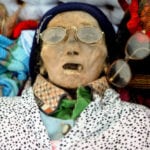 History
History  History
History  Technology
Technology Top 10 Everyday Tech Buzzwords That Hide a Darker Past
 Humans
Humans 10 Everyday Human Behaviors That Are Actually Survival Instincts
 Animals
Animals 10 Animals That Humiliated and Harmed Historical Leaders
 History
History 10 Most Influential Protests in Modern History
 Creepy
Creepy 10 More Representations of Death from Myth, Legend, and Folktale
 Technology
Technology 10 Scientific Breakthroughs of 2025 That’ll Change Everything
 Our World
Our World 10 Ways Icelandic Culture Makes Other Countries Look Boring
 Misconceptions
Misconceptions 10 Common Misconceptions About the Victorian Era
 Mysteries
Mysteries 10 Strange Unexplained Mysteries of 2025
 History
History 10 Things You Didn’t Know About the American National Anthem
 Technology
Technology Top 10 Everyday Tech Buzzwords That Hide a Darker Past
 Humans
Humans 10 Everyday Human Behaviors That Are Actually Survival Instincts
Who's Behind Listverse?

Jamie Frater
Head Editor
Jamie founded Listverse due to an insatiable desire to share fascinating, obscure, and bizarre facts. He has been a guest speaker on numerous national radio and television stations and is a five time published author.
More About Us Animals
Animals 10 Animals That Humiliated and Harmed Historical Leaders
 History
History 10 Most Influential Protests in Modern History
 Creepy
Creepy 10 More Representations of Death from Myth, Legend, and Folktale
 Technology
Technology 10 Scientific Breakthroughs of 2025 That’ll Change Everything
 Our World
Our World 10 Ways Icelandic Culture Makes Other Countries Look Boring
 Misconceptions
Misconceptions 10 Common Misconceptions About the Victorian Era
 Mysteries
Mysteries 10 Strange Unexplained Mysteries of 2025
Top 10 Horrifying Ancient Medical Practices . . . We Still Practice
The history of medicine is as animated as man himself, and society owes at least half its life to the doctors who, in any form, pursued cures and relief without tire or relent. From fauna to Obsidian blades to electric shock therapy, practitioners of old left almost nothing to the imagination, including treatments that may have started so revoltingly wrong yet somehow trumped the test of time, reason, and the law.
Here are the top 10 horrifying ancient medical treatments that we still practice today.
10 Fecal Microbiota Transplant
Over a thousand years ago in China, an ancient researcher and healer named Ge Hong treated diarrhea with “yellow soup,” and it worked! The soup was made of human poop, and the approach later came to the West, where it is now known as fecal microbiota transplant (FMT). Today, the therapy is used to combat persistent Clostridium difficile infections, which lead to uncontrolled diarrhea and abdominal aches serious enough to impact quality of life and bring deadly complications.
The problem with modern antibiotics is their inability to discriminate between healthy and harmful bacteria, causing them to eliminate both when combatting an infection. With FMT, a patient gets a healthy dose of good gut bacteria and builds up a stronger defense against C. difficile. Modern medicine has practiced poop therapy since the 1980s, but lo and behold, people no longer have to slurp it from a bowl (gross). Doctors now administer the treatment either straight to the colon through colonoscopy, an enema, or ingested as a safe, sterile pill.
9 Maggot Therapy
Flies and wounds make not a good pair—unless the flies come in live, decontaminated larvae in an age-old medical procedure called maggot therapy (myiasis). Repulsive as it may sound, maggots have been curing infected wounds from as far back as in the Old Testament as told in the Book of Job. In the American Civil War, doctors used maggot therapy to debride and disinfect injured soldiers’ wounds. Its simple mechanics and ability to promote speedy healing, makes the benefits of maggots handy in or out of battle.
So what is it about maggots that bring even the ruthless cynic that is modern medicine to heel? For one, these bugs can dissolve up to 25 micrograms of necrotic tissue in under 24 hours, including infectious bacteria that burrows within. They are also self-limiting organisms that attack only dead flesh and leave out the healthy, allaying doctors’ fears of excessive tissue damage. While the practice is almost as old as time, maggot therapy was only approved by the FDA in 2004 as a single-use medical device that must be stored under sterile conditions and disposed of as biohazardous waste.
8 Leech Therapy
Besides maggots, leeches are another type of primeval worms that have been used medicinally since the early times. Neither slugs, reptiles, insects, or bugs, these invertebrates belong to a separate zoological category occupied by bristle worms. With suckers on both tips of their bodies and teeth that cut neatly into skin, leeches make perfect therapy for conditions like venous congestion, in which blood accumulates in a certain area of the body when the veins are unable to pump blood back to the heart.
In 2004, the FDA approved the use of leeches for medical purposes, particularly following surgeries such as limb reattachment and breast reconstruction. True to their reputation, these organisms are impeccable suckers, able to extract a substantial amount of blood in just 45 minutes. Aside from resolving blood pools, leeches also increase oxygenation around the affected area as they draw blood to it, as well as prevent blood clots through their blood-thinning saliva. Anemia is a major risk to maggot therapy, but this is usually handled easily in any well-managed medical environment.
7 Tapeworm Diet
At the beginning of time, malnutrition was the bane of humanity. Thanks to the 1800s, technology made food more accessible and exciting. But people also began to disregard their health out of will or ignorance, unwittingly creating another imbroglio. Thus, obesity was born! While there was so much to learn about the disease at that time, Victorian women were more radical in finding a cure. After all, they were struggling beneath their corsets! The salve? Tapeworms.
Created by a lady doctor in Scheffield City in Yorkshire, England, the tapeworm diet consisted of swallowing a pill filled with tapeworm larvae. Once the eggs hatched, women counted on them to eat whatever they put in their mouths and waited for the weight to come off. Indeed, there was no question about the magic of tapeworms in depleting the body’s nutritional stores, but the idea was as disgusting as it was dangerous—if only they knew it then. Doctors today are quick to warn against the potential complications of the tapeworm diet, including blocked bile ducts, respiratory failure, and dementia, among others. Unbelievably, the practice is still alive today.
6 Bee Venom Therapy
When ancient Greeks suffered arthritis and other joint problems, they took to bees to sting them with their venom. We know treating illnesses using bee products, which also includes honey and pollen, today as apitherapy. The practice dates back to the time of Hippocrates who himself used and advocated the method. Found in bee venom is a protein called melittin, which has proven anti-inflammatory properties but remains under scrutiny for other claimed effects, such as fatigue prevention and multiple sclerosis management.
Despite its continued use, bee venom therapy is not approved by the FDA, not only for its mostly unverified benefits but especially for its risks. According to a 2015 South Korean study, bee venom may cause not only skin irritation but also anaphylactic shock. Anaphylactic shock causes a person’s airways to narrow and makes breathing partially or completely impossible. While rarely used in the U.S., this type of apitherapy is still relatively common in Asia, Eastern Europe, and South America. In modern apitherapy, doctors inject bee venom using a hypodermic needle. The natural method involves exposing the patient to bees until they are stung.
5 Cauterization
In the Middle Ages, back when antibiotics were inconceivable, and wounds were considered as grave as any deadly disease, treatment came under fire—literally. People burned open flesh to prevent blood loss, close amputations, seal gums after tooth extraction or even treat mental illness. Thankfully, this barbaric method soon made way for heated lancets and knives that produced the same therapeutic results as fire, without leaving patients as traumatized. In 1926, American scientist William T. Bovie invented a cautery tool made of iron and used it in collaboration with a physician friend who attempted to excise a tumor without excessive bleeding. The operation was successful, and electrosurgery was born.
Electrosurgery is simply cauterization that relies on electricity to generate the heat to achieve the doctor’s objectives. While the tools have changed, the uses have remained the same with a few additions, such as removing warts and other unsightly skin growths. The treatment is also generally safer today, with minimal bleeding, discomfort, and infection being the most serious side effects reported.
4 Electroconvulsive Therapy
Electroconvulsive therapy (ECT) almost became a household name in the 1940s and 1950s as a cure for mental illness, but its history dates back to ancient times when electric eels and fish were used as antidepressants and analgesics. By the late 1930s, Italian psychiatrists had discovered the power of electricity-induced seizures. Still, while the idea of shocking the brain was frightening by itself, it was ironically developed as an alternative to Metrazol. This seizure-inducing drug put mental patients in a more terrifying place.
Over time, ECT lost its popularity as a cure for mental disorders mainly because it was administered in high doses without anesthesia, leading to serious side effects such as memory loss and brittle bones. Despite the stigma attached to the procedure, it continues to be performed today but only when other options have failed. The once-controversial therapy is also much safer in modern times, with success rates as high as 80-85%. While side effects can still occur, ECT therapy is now conducted in highly controlled settings designed to provide the most possible benefit with the least potential risk.
3 Plombage Thoracoplasty
Before tuberculosis was treated with chemotherapy and antibiotics, doctors used plombage thoracoplasty, also known as collapse therapy, to forcibly collapse the lungs and allow the organ to rest and heal faster. The practice, which emerged in the 1930s, required creating a cavity under the upper ribs and filling that space with paraffin wax, rubber sheets, ping-pong balls, and other materials that put pressure on the lungs to keep them from inflating. Unsurprisingly, patients experienced a whole range of serious complications affecting the lungs and even the esophagus, heart, and skin.
Surgeons pulled the plug on plombage thoracoplasty in the 1950s, after which few of the last wave of patients made it out alive long after the surgery. Today, doctors still use the treatment for certain conditions, such as empyema, in which pus collects between the lungs and inner surface of the chest wall. However, it is important to note that plombage thoracoplasty has never been evaluated with randomized trials, so it remains a step in the dark for the medical community.
2 Trepanation
Headaches may be a case of the aspirins today, but Paleolithic doctors liked to fix them by drilling holes in people’s skulls. Known as trepanation, the procedure was one of the most shocking treatments ever used in primitive medicine, particularly for brain conditions such as seizures, cerebral hemorrhage, depression, and other mental disorders. Archaeologists have even unearthed evidence of trepanning as an exorcising ritual in a Russian port city Rostov-on-Don. While the first trepanations bored through a skull using an incredibly sharp stone known as an Obsidian blade, surgeons developed mechanical drills to improve surgical efficiency.
What makes these surgeries even more stunning is the high survival rate among those who went through them under the most archaic tools, not once, but repeatedly in some cases. Moreover, doctors still practice trepanation today to treat certain types of traumatic brain injury, albeit using safer, painless, and more sophisticated instruments. It also has a more modern name: craniotomy. While some surgeons still use Obsidian blades, particularly in cosmetic medicine, these instruments are not FDA-approved.
1 Lobotomy
A descendant of skull-drilling trepanation, doctors introduced lobotomy in the 1930s as a psychosurgery that removed certain brain nerves. Psychiatrists believed these nerves to cause depression, anxiety, and other forms of emotional instability. Surgeons performed the procedure with a sharp instrument resembling an ice pick, lodged into the sedated patient’s eye socket, and moved back and forth into the brain’s frontal lobes. In the 1940s, mental hospitals in the U.S. were full to the brim, and lobotomies served to decongest them by treating patients with schizophrenia, bipolar disorder, and psychosis.
Despite lobotomy’s horrid nature, the world’s first lobotomist and creator of the procedure, Portuguese neurologist Egas Moniz, received a Nobel Prize in 1949 for his invention. The procedure went on to peak well into the end of the half-century. By this time, experts introduced the first batch of effective psychiatric drugs, and lobotomy gradually fell into disesteem. Interestingly, doctors still practice it today, albeit extremely rarely using more elegant and sophisticated tools. It is only a last resort for patients who have not responded to all other kinds of treatments.








